In and around Xcalak many activities can be done. Most
activities are related to sports and nature. Pick your favorite:
| Local Diving |
 Xcalak
is the most famous for diving. The Meso American reef runs just a couple of
hundred meters from the beach. The Meso American reef is a thousands of kilometers
long reefs system. The second largest in the entire world. This reef offers
and endless list of great dive sites. The dive sites feature animals like
tarpon, jack, giant midnight blue parrotfish, snapper, lobsters, moray eals,
fry, conch and nurse sharks. Besides an abundant animal life there is also
an abundant coral life like black coral and giant sponges. The fish and the
coral can be seen in impressing underwater structures like coral walls,drop
down,canyon formations and caves.
Xcalak
is the most famous for diving. The Meso American reef runs just a couple of
hundred meters from the beach. The Meso American reef is a thousands of kilometers
long reefs system. The second largest in the entire world. This reef offers
and endless list of great dive sites. The dive sites feature animals like
tarpon, jack, giant midnight blue parrotfish, snapper, lobsters, moray eals,
fry, conch and nurse sharks. Besides an abundant animal life there is also
an abundant coral life like black coral and giant sponges. The fish and the
coral can be seen in impressing underwater structures like coral walls,drop
down,canyon formations and caves.
 Around
Xcalak you will find the following sites:
Around
Xcalak you will find the following sites:
- Hob Na
- Santa Julia
- La Poza Rica
- Blanquizar
- Ciudad Undida
- Sieto Cocos
- Doña Nica
- Cañones
- La Poza del Quebrado
- G-Spot
- La Poza
- La Pozeta
- Blanquizares
- Portilla
- Coral Garden
- Chimenea
- Scott's Playground
- Bahia de Chetumal
You can arrange diving trips to the local reefs with the diving school XTC
Diving, Costa de Cocos, Blue Ha diving and Maya Palms diving . Also several other hotels have their
own equipment for diving trips.
| Cenote diving |
 Mexico
is famous for it's cenotes. The ground of the Yucatan Peninsula is to hard
to absorb the rainwater sufficiently. The rainwater has therefore cut large
caves into the ground. There is an enormous amount of this kind of wells or
cenotes.
Mexico
is famous for it's cenotes. The ground of the Yucatan Peninsula is to hard
to absorb the rainwater sufficiently. The rainwater has therefore cut large
caves into the ground. There is an enormous amount of this kind of wells or
cenotes.
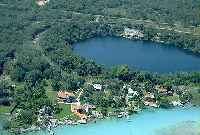 Cenote
Azul is near Xcalak. Cenote
Azul is the largest pit cenote in Mexico, 600 feet across and 290+ feet at
the center. The diving here is the most bizarre and thrilling fresh water
dive you will ever experience. The geological formations look more like a
moon-scape with submerged trees populated by schools of live bearing, fresh
water fish. At 100+ feet, you can look up and see swimmers above but not the
bottom. During the first dive, you will drop down through the clear blue water
to a ledge at 90-100 feet, we then progress along the wall in a multilevel
dive. For the surface interval, you can lounge in the sun or enjoy some fine
local cuisine in the Cenote Azul restaurant. The second dive will be conducted
at 50-60 feet and often we can make a complete circuit of the cenote in 40
minutes. The water in this cenote is much warmer than what you will commonly
experience in the smaller cenotes, with an average year round temperature
above 80° F.
Cenote
Azul is near Xcalak. Cenote
Azul is the largest pit cenote in Mexico, 600 feet across and 290+ feet at
the center. The diving here is the most bizarre and thrilling fresh water
dive you will ever experience. The geological formations look more like a
moon-scape with submerged trees populated by schools of live bearing, fresh
water fish. At 100+ feet, you can look up and see swimmers above but not the
bottom. During the first dive, you will drop down through the clear blue water
to a ledge at 90-100 feet, we then progress along the wall in a multilevel
dive. For the surface interval, you can lounge in the sun or enjoy some fine
local cuisine in the Cenote Azul restaurant. The second dive will be conducted
at 50-60 feet and often we can make a complete circuit of the cenote in 40
minutes. The water in this cenote is much warmer than what you will commonly
experience in the smaller cenotes, with an average year round temperature
above 80° F.
| Banco Chinchorro diving |
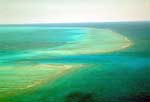 Part
of the Meso American reef is the famous Banco Chinchorro, an atoll shaped island.
The distance from Xcalak is approximately 60 Km and takes a 1 1/2 hour boat
ride to visit. The atoll is the largest of the northern hemisphere. Banco Chinchorro
has abundant sea life including sharks.
Part
of the Meso American reef is the famous Banco Chinchorro, an atoll shaped island.
The distance from Xcalak is approximately 60 Km and takes a 1 1/2 hour boat
ride to visit. The atoll is the largest of the northern hemisphere. Banco Chinchorro
has abundant sea life including sharks.There are many ship wrecks to be found around Banco Chinchorro. The wrecks date from the colonial times when many unfortunate sailors banked their ship on this beautiful reef system.
The best dive spots can be found on the east side of the atoll. The reason for this is that this is the place where the numerous Spanish colonial ships and steam ships stranded on the coral. The wrecks can be found on the following locations:
- Penelopez

- SS Ginger Screw
- SS Glen View
- SS Five Star
- Spanish Galleon Anchors
- Spanish Galleon 2
- SS Caldera
- Spanish Galleon
- 40 Cannons
- Mary
Diving on Banco Chinchorro can be done with XTC
Diving and Caribbean
Excursions. Also some hotels offer diving on Banco Chinchorro.
| Snorkeling |
The water's visibility is so clear that often you can
see up to 30 meters. There are many small coral outcroppings just off the
coast of Xcalak. These are home to an abundance of fish life. Often times
schools of brightly colored fish will be swimming around these small coral
mounds. These mounds are spaced such that you can swim from one to the next
and slowly make your way out to where the waves are crashing about 500 m of
a mile offshore. The ocean floor varies between a depth of several feet upwards
to 5 meters between the shoreline and where the waves are crashing. However,
each small coral mound rises to only several feet below the water's surface.
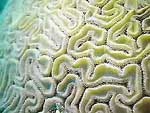 One
type of coral may stand out from your underwater adventures in this area.
The brain coral (Colpophyllia natans) gets its name from the hundreds of small
curved channels that exist on its surface. It usually grows into a spherical
shape and is found in waters from approximately 1 meter to 60 meters. It can
grow up to 2.5 meter in diameter although 0.5 meter examples are much more
common. If you look carefully on shore you may find several that
One
type of coral may stand out from your underwater adventures in this area.
The brain coral (Colpophyllia natans) gets its name from the hundreds of small
curved channels that exist on its surface. It usually grows into a spherical
shape and is found in waters from approximately 1 meter to 60 meters. It can
grow up to 2.5 meter in diameter although 0.5 meter examples are much more
common. If you look carefully on shore you may find several that
have washed up during severe storms.
You can arrange snorkeling trips on the local reefs and Banco Chinchorro with
the diving school XTC Diving. You can also try to persuade one of the local
fishermen to bring you to a nice local reef. Several hotels have their own
boat for doing snorkeling trips.
| Biking |
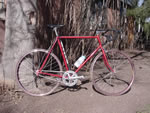 The
best way of transportation and exploration in Xcalak is by bike. The coastal
sand road will show you all the magnificent trees and you won't be scaring of
the tropical birds with car noise. There has been made a track to the Laguna
Cemetario, just south of Xcalak. Another interesting ride is to the Chetumal
Bay. Most hotels rent out well fitted bikes. Bring your hat and enough to drink
for your adventure. If you venture into the jungle put on some insect repellent.
The
best way of transportation and exploration in Xcalak is by bike. The coastal
sand road will show you all the magnificent trees and you won't be scaring of
the tropical birds with car noise. There has been made a track to the Laguna
Cemetario, just south of Xcalak. Another interesting ride is to the Chetumal
Bay. Most hotels rent out well fitted bikes. Bring your hat and enough to drink
for your adventure. If you venture into the jungle put on some insect repellent.
| Kayaking |
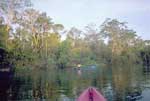 The
calm sea on the Xcalak coast is perfect for kayaking. The shoreline
is protected
by an offshore coral reef which is the second largest in the world just behind
the Great Barrier Reef in Australia. The water is extremely clear and
fish
life is abundant. The depth of the ocean floor varies between 1/2 m 5 m between
the reef and the shoreline but then right at the reef it is 1/2 m and
you
need to be careful to not damage the pristine reef.
The
calm sea on the Xcalak coast is perfect for kayaking. The shoreline
is protected
by an offshore coral reef which is the second largest in the world just behind
the Great Barrier Reef in Australia. The water is extremely clear and
fish
life is abundant. The depth of the ocean floor varies between 1/2 m 5 m between
the reef and the shoreline but then right at the reef it is 1/2 m and
you
need to be careful to not damage the pristine reef.
There are several pristine lagoons with there
specific wild life. There is a large lagoon next of town, a large lagoon north
of town called Laguna Canal and one large lagoon just south of town called
Laguna Cementerio.
| Fishing |
![]() Fly Fishing
Fly Fishing
Xcalak has been a favorite destination for fly-fishing.
Long before the new paved highway, fishermen made the 3-hour trek from Mahahual (Majahual)
just to fish the pristine flats that surround this area. Year round, we catch
and release bonefish, tarpon, permit, and more.
![]() Trolling
Trolling
This area has been renowned for its fantastic fly-fishing,
yet few people have tried the wonderful trolling. Year round, we catch sierra,
jacks, tuna, barracuda, grouper, snapper, permit, and tarpon. During April
through June, we also catch lots of dorado, marlin, and sailfish.
Ask for Nato or Victor
at the XTC dive shop or ask at Costa the Cosos, they are excellent guides.
Costa de cocos introduced fly fishing to this area, through Mark Cowan from
taos, who mapped out the flats, and trained most of the guides in this village.
They have four flat boats for fly fishing.

![]() Tips:
Tips:
For Barracuda bring Klauser minnows in yellow or green. For bone fish, Crazy
Charlies in light shades of brown, yellows and greens are pretty good. Also
some small crab imitations will assure you with a hookup.
| Sailing |
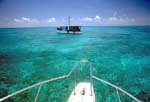 Sailing
is one of the best ways to get to Xcalak from Belize or from the north of
the Mexican
coast.
Sailing
is one of the best ways to get to Xcalak from Belize or from the north of
the Mexican
coast.
The best sailing experience is to sail with a small boat or a catamaran along
the beautiful coast line. The conditions for sailing are perfect, there
is
always a nice Caribbean breeze and the waves are small due to the reef. Check
with your hotel if they have a sailboat or catamaran available.
In Mahahual (Majahual) a 35 feet catamaran can be chartered for day trips.
| Windsurfing or Kitesurfing |
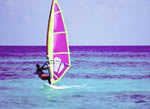 The
sea at Xcalak is perfect for windsurfing and kitesurfing. There is always
a Caribbean breeze. Check with your hotel for your gear.
The
sea at Xcalak is perfect for windsurfing and kitesurfing. There is always
a Caribbean breeze. Check with your hotel for your gear.
| Horse riding |
 Local
farmers have good riding horses to enter the lush Xcalak jungle and bushes.
There is a 10 mile trail south of town that leads to a pristine Laguna de
Cemetario This lake is about 100 acres.
Local
farmers have good riding horses to enter the lush Xcalak jungle and bushes.
There is a 10 mile trail south of town that leads to a pristine Laguna de
Cemetario This lake is about 100 acres.
Riding through the shallow sea on the unspoiled beaches
is an adventure never to forget.
In Mahuhual town you can find horses for a trip along the beach.
| Hiking |
You can walk along the endless pristine beaches of Xcalak or
follow the Beach road. On the beach road you will find all kinds of animals
like the Cacomixtle or the Coatimundi. In the trees you might find parrot
like birds. A walk to the Laguna Cemetario can be worth your effort. Ask Alan
in the Xcalak Caribe restaurant for directions.
Don't forget your insect repellent when you are going land inwards.
| Trips |
From Xcalak you can make many trips. Here
are some suggestions.
![]() Bird Island
Bird Island
Bird Island is located in the Bay of Chetumal. On the way
there from Xcalak you can snorkel at different locations in the ocean and
the Bacalar Chico River. Once you enter the Bay of Chetumal, you will travel
through ancient Mayan canals that were once part of a trade route. You can
stop on one island and see an abandoned antique steam engine. Also, you may
visit the canons from a Spanish galleon that was stranded during a hurricane.
The final destination is a small island where many rare species of birds nest.
This trip allows you to see the diversity of ecosystems that surround Xcalak-
if you are really lucky, you may even spot a manatee!
![]() Swim with Dolphins
Swim with Dolphins
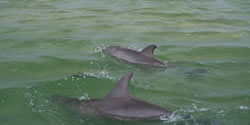 The Dolphin Interactive Swim is located at Uvero Beach Club. There can be a maximum of 10 people per dolphin. Each interactive swim lasts approx. 30 minutes.
The Dolphin Interactive Swim is located at Uvero Beach Club. There can be a maximum of 10 people per dolphin. Each interactive swim lasts approx. 30 minutes.
![]() Bacalar
Bacalar
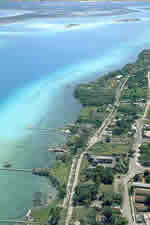 Bacalar
is a small town located near highway 307. The driving distance from Xcalak
is about 1 1/2 hours. Bacalar is known for for three things: Laguna
Bacalar, Fortress, Cenote Azul.
Bacalar
is a small town located near highway 307. The driving distance from Xcalak
is about 1 1/2 hours. Bacalar is known for for three things: Laguna
Bacalar, Fortress, Cenote Azul.
![]() San Pedro
San Pedro
 From
Xcalak it is an easy day trip to San Pedro (Belize) by boat. The boat can
take then 'outside' route over sea or the 'inside route which goes throught
the river Boca Bacalar Chico and the lagunas in the Chetumal Bay.
From
Xcalak it is an easy day trip to San Pedro (Belize) by boat. The boat can
take then 'outside' route over sea or the 'inside route which goes throught
the river Boca Bacalar Chico and the lagunas in the Chetumal Bay.
You can ask the local
dive operators in Xcalak. The price for the trip is about 175 USD for
a boat with max. 6 persons. The trips takes the whole day. The operator will
help you to go through the proper border control procedures. Some nationalities
need a visa to get into Belize. The visa costs 25 USD. Please check this before
you leave.
Once in Belize you can do some shopping in the busy town center of San Pedro.
There are many operators that will bring you to the famous dive locations
like the Blue
Hole National Park, Turneff Island and many others. Snorkeling is a great
experience at the Hol
Chan Marine Reserve and Shark Ray Alley.
![]() Archeological sites
Archeological sites
The Rio Bec and Chennes sites are one of the latest found in Mexico. Most
of the sites were found by rubber farmers scouting the forest in search of
rubber trees. The discovered sites are;
| Rio Bec: | Chennes: | Petén | Others: |
| Rio Bec | Chicanná | Oxtankah | Coba |
| Calakmul | Becán | Chacchoben | |
| Rio Azul (Guatamala) | Xpuhil | ||
| Naachtúm (Guatamala) | Dibanche | ||
| Uaxactún (Guatamala) | Kohunlich | ||
| Tikal (Guatamala) | |||
| Nakum (Guatamala) | |||
| Mutul (Guatamala) | |||
| Tayasal (Guatamala) | |||
| Naranjo (Belize) |
![]() 'Guerreros'
orchid and bromelia garden
'Guerreros'
orchid and bromelia garden
The 'Guerreros'
orchid and bromelia garden is set in the typical Costa Maya environment
of ponds and forest. In the forest you can also find other plants that are
often seen on the Costa Maya. There are lots of interesting birds and many
types of insects to be found. In the night small crocodiles come out to the
garden.
The garden is located on the Cafetal - Mahahual (Majahual) road approx.
7 km from Cafetal.
![]() Chetumal
Chetumal
Chetumal is the largest city near to Xcalak. Chetumal is well
worth a visit because of the Museo de la Cultura Maya. And of coarse for it's
transportation capabilities.
| Sports |
You can play soccer and basketball on the local fields in Mahahual and Xcalak.
| Delta Flying |
 At
this moment there are no facilities for (motorized) Delta flying at the Xcalak
airport. However It can not take long before someone takes up the challenge
of showing the beautiful scenery to visitors.
At
this moment there are no facilities for (motorized) Delta flying at the Xcalak
airport. However It can not take long before someone takes up the challenge
of showing the beautiful scenery to visitors.
| Golf |
The Las Vegas Golf Club at Bacalar is currently under development
and will be one of the nicest golf courses in the Caribbean, this 18-hole
course also offers an attractive modern spa. A new golf course is planned
near Mahahual (Majahual).
Las Velas Gold Bacalar Resort Golf & Spa
27 km/Chetumal-Cancun Highway
MEX-77500 Bacalar, Qintana Roo